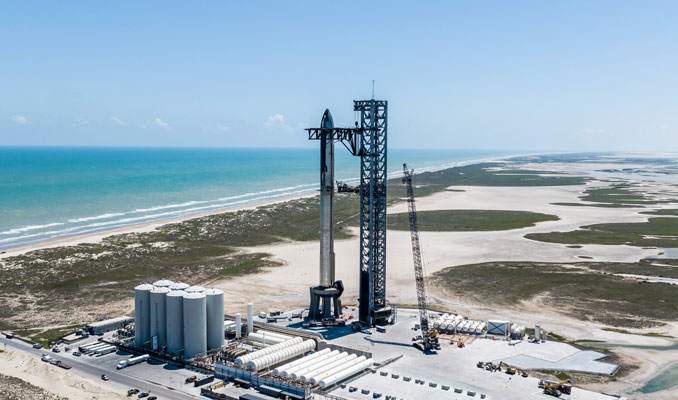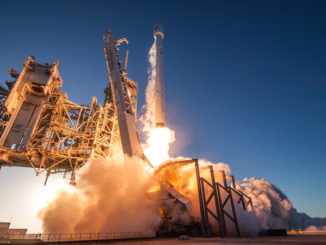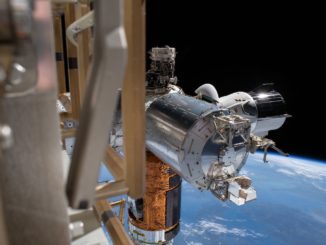
More than half a year after its first flight, SpaceX believes it’s on the cusp of getting to launch its Starship rocket for a second time.
On Friday afternoon, the company updated its website to announce that the second integrated flight test (IFT-2) of it’s towering rocket “could launch as soon as mid-November, pending regulatory approval.” Sources suggest the launch could be as soon as Nov. 13, but that’s far from set in stone.
Those regulatory hurdles surrounding the fully reusable launch vehicle are now mainly centered around the conclusion of an environmental review, which is in the hands of the U.S. Fish and Wildlife Service (FWS).
Earlier this week, the Federal Aviation Administration (FAA) said it had concluded the Starship-Super Heavy safety review. In a statement to Spaceflight Now, the agency said that “The environmental review is the last major element to complete before the FAA makes a license determination.”
SpaceX will debut a number of upgrades to both the rocket itself as well as the launch infrastructure, including their new hot-stage separation system and an electronic Thrust Vector Control (TVC) system.
The FWS has been evaluating one of the key upgrades since IFT-1: the water-cooled steel flame deflector aka the water deluge system.
Reached for comment early Friday morning, an FWS spokesperson said they didn’t have any updates to provide regarding their progress.

Road to the Moon
As was the case with the IFT-1 mission earlier this year, NASA has been eagerly watching the progress of Starship.
SpaceX only has so much time to move through evolutions of Starship before it’s needed to operate as the first vehicle that will be a part of the Human Landing System Program within the overall Artemis Program.
During 2024, SpaceX is expected to demonstrate its ability to transfer propellant from one Starship vehicle on orbit to another, a key milestone needed within the architecture of safely getting the spacecraft to the Moon, down to the surface and back into lunar orbit.
“That will be a really key indicator as to their readiness level,” said Lisa Watson-Morgan, the HLS Program Manager. “And once they get to that point, and once that is achieved, it’s much smaller from there on out.”
That propellant transfer mission will also call upon at least one additional orbital launch mount, which adds to the importance of being able to demonstrate either the success of the changes made or showcase what still needs to be adjusted.
Watson-Morgan told Spaceflight Now last month that this iterative approach can be tricky to step through, but makes things more simplified by the end of the testing campaign.
“And so what that means is by the time they’re at the end of their test campaign, they’re pretty much ready to fly. It’s more of a just, here’s the rest of the documentation. Let’s go in and certify,” Watson-Morgan said. “So, while yes, these are early developmental flights, and they’re not what the Human Landing System Starship will be, in that it doesn’t have our life support, it doesn’t have our comm system, it doesn’t have those aspects, but it is still very important and required. So for us, schedule is key.”
We’ll see when launch number two ends up on the schedule.




Is that based in fact that FWS is near completion, or is this a PR stunt to put political pressure on FWS to force them to rush ?
i.e. There has to be someone, or some agency to blame if this “poised for” launch does not happen now. We’ve had our congressional hearing over the FAA, and now it’s time to chase after the FWS. It’s could never be that SpaceX located their launch facility adjacent to a wildlife refuge now ( why ??) – could it, and have to deal with the complexities that every other company in our nation has to deal with – rules and regulations – that slows things down.
I’d like to see articles like this be backed up with information that substantiates why they believe they will be granted permission to launch. I’m tired of having to apply what I call the “E” exaggeration factor – take the schedule told – and multiply by 2 or 3. Like after the April test – they mentioned they would be ready again in two months. I took that and multiplied by 2 or 3 and said – ok, that really means 4 or 6 months. And here we are now – about that time on the upper end. It gets tiresome. And boring.
Why does he not build an ocean platform and launch away from the coast? Would be cheaper and less regulations. The political situation is against him suceeding. Also it would protect the enviornment.
There should be a launch every 2 months to get this working right.
Utterly ridiculous that a fish and wildlife organization is given the power to say when a cutting-edge, highly advanced spaceflight company can launch. So…how is the FWS qualified for this kind of decision that will effect not only future spaceflight but national security? It’s like letting the Girl Scouts tell the US military when to deploy to the South Pacific or to the middle east.
While on the other side of the world that nation, China, that continually seeks to undermine and pilfer US technical prowess steams ahead with its massive new heavy lift rockets without a care as to any environmental regulations or to where their rocket stages land in the world, all in a mad frenzy to beat the US to the moon, which thanks to the FWS might actually happen.
Perhaps NASA’s stated goal of putting the first person of color and the first woman on the moon will actually be Chinese nationals.
And then China can tell the US to stay away and explore somewhere else while they prepare future military bases on the moon as they’ve done on Earth.
The only thing that can prevent this possible future is Starship.
So…thanks again, FWS.
There should be no environmental review. Let’s go back to the times when the titans of industry could pump whatever they wanted into the waterways and air.
everyone needs to relax, the FWS just got to monitor the deluge system at full pressure and I suspect max launch cadence less than two weeks ago, they need to monitor how quickly the tidal flat returns to pre deluge conditions (one to ten high tides?). once thats done they will give the aproval and all the environmental lawsuits can be tossed out. they aren’t trying to hinder anything, not like the WDR was done months ago. they are doing the due diligence which is fine. heck, spacex was still messing with the hot ring 3 weeks ago and stacking and unstacking starship daily, just because Elon said it was ready in september doesn’t mean it was, it didn’t go through a WDR then now did it?
You don’t want to get too far ahead of yourselves.
Looking back; the V2 had anomalies because of vacuum across the hull at speed. The German engineers added bands around the mid section.
You seem to be longer and faster than Falcon 9; so you might be facing a double whammy; ( the lac of atmospheric pressure forward and Venturi midship). Pressure sensitive equipment with command computer read outs and strain gauges might be in order.